Physical Address
304 North Cardinal St.
Dorchester Center, MA 02124
Microscopic or gross hematuria is suggestive of genitourinary trauma; however, the degree of hematuria does not correlate well with either the severity or anatomy location of injury.
The kidney is the most frequently injured genitourinary organ, and imaging should be considered in patients with gross hematuria or microscopic hematuria with hemodynamic instability.
Most noniatrogenic ureteral injuries are due to penetrating mechanisms and are unilateral; blunt ureteral trauma is rare. Delayed computed tomography (CT) images after intravenous (IV) contrast should be obtained in patients with mechanism or findings suggestive of ureteral trauma.
CT scan with IV contrast is not sensitive for diagnosing bladder injury, and retrograde cystography should be obtained to allow proper distention of the bladder to allow for urinary extravasation.
Pelvic fractures associated with hematuria strongly suggest bladder or urethral injury.
Retrograde urethrography (RUG) should be performed in patients with pelvic fractures and hematuria, those with perineal ecchymosis or swelling, or those with blood at the urethral meatus, prior to attempting bladder catheterization, because blind passage of a Foley catheter in these scenarios can worsen a preexisting urethral injury.
Genital injury is rarely life threatening but prompt diagnosis and evaluation are necessary to decrease the likelihood of future morbidity in these patients.
Ten percent of trauma cases in the United States involve the genitourinary tract; however, most of these injuries are not life threatening. In fact, due to the anatomic protection of the kidneys, ureters, and bladder, as well as the mobile nature of the male external genitalia, isolated urologic injuries are uncommon in patients with major trauma. However, genitourinary trauma can cause significant, long-term morbidity, including renal insufficiency, chronic hypertension, incontinence, and sexual dysfunction. In addition, isolated traumatic renal injuries can be overlooked, due to the location of the kidneys and subtle presentation, with serious consequences for the patient.
Approximately 5% of all trauma patients will have a concomitant renal injury, with a male predominance of 3:1. Blunt mechanisms cause the vast majority of renal injuries. Although approximately half of all traumatic renal injuries are caused by motor vehicle collisions, it remains an uncommon injury that has continued to decrease with improvements in seat belts and airbags. Recent data show that less than 1% of all motor vehicle collisions result in any genitourinary trauma. Although rare, 40% of patients with renal trauma also have a coexisting abdominal injury. Contrastingly, in urban or military settings, penetrating trauma accounts for 40% of renal injuries, and typically causes more tissue disruption and a higher severity of injury. Of the remaining blunt mechanisms, falls and direct blows (e.g., sports injuries or assaults) account for the majority of injuries. Renal injuries from sports (e.g., skiing, snowboarding, and contact sports) tend to be isolated and can easily be overlooked.
Pediatric renal injuries tend to be more common than in adults because children’s kidneys are more mobile, are relatively larger, and have less perinephric adipose tissue. Blunt mechanisms are responsible for 90% of pediatric renal trauma. Kidney injuries are more common than injuries to the spleen, liver, pancreas, and bowel in this population. However, due to more conservative approaches in management, even with high-grade injuries, pediatric renal trauma rarely leads to nephrectomy.
Due to the long, tubular and mobile nature of the ureter and its location in the retroperitoneum (where it is well protected by the vertebrae and soft tissues), blunt traumatic injuries of the ureter are rare and virtually never occur in isolation. Most noniatrogenic ureteral injuries are due to penetrating mechanisms and are unilateral; the ureter is involved in up to 5% of penetrating injuries to the abdomen.
After the kidney, the bladder is the most commonly injured genitourinary organ with blunt trauma. Bladder injuries occur in 1% to 2% of all blunt abdominal traumas and occur most frequently from motor vehicle collisions, which are responsible for approximately 50% of all bladder injuries. Bladder injury most often occurs in the context of pelvic fractures or other intra-abdominal injuries. As a result, mortality rates in patients with blunt bladder trauma is as high as 22%, due mostly to the concomitant injuries. The bladder also is subject to penetrating injury through the abdomen, rectum, or buttocks. Up to 80% of patients with penetrating bladder injuries also suffer bowel injuries.
Blunt trauma mechanisms, the majority of which are motor vehicle collisions, cause approximately 90% of urethral injuries. Males are five times more likely than women to suffer urethral injuries, due to the longer length and reduced mobility of the male urethra. Similar to bladder injuries, significant blunt pelvic trauma is required to cause injuries to the urethra. As a result, concomitant injuries are often observed, particularly pelvic fractures or straddle-type injuries. Approximately 5% of pelvic fractures have an associated urethral injury. Penetrating injuries to the urethra are rare (3% of all gunshot wounds) and are suspected on the basis of the nature and trajectory of the penetrating object. Urethral trauma also can occur from misadventure during self-instrumentation, which is most often related to sexual activity. Urethral injury can cause significant morbidity, via stricture formation, incontinence, erectile dysfunction, and infertility. These injuries tend to occur in younger patients, and complications are common, even if urethral injuries are appropriately diagnosed and treated.
The external genitalia, particularly the scrotal contents, are subjected to direct injury, which happens most frequently in sports-related trauma. Minor external trauma may occur with consumer products (including zippers, sporting items, and moving furniture), and the large majority of these injuries are self-limited. Severe injuries, including penile fractures and testicular rupture, are rare but generally require emergent surgical management. These injuries also can lead to long-term reproductive, physiologic, and psychological consequences.
The overall rates of external genital trauma are low in females, with the most common mechanism being childbirth-related injuries. However, blunt trauma, causing lacerations or hematomas, can occur. Unfortunately, in many parts of the world, female genital mutilation and sexual violence can lead to disfigurement, sexual dysfunction, and incontinence.
The genitourinary tract is divided into the upper tract (kidneys and ureters, including the renal pedicle), lower tract (bladder and urethra), and external genitalia (penis, scrotum, testicles, and vulva).
The kidneys are retroperitoneal organs that are encapsulated by fibrous tissue known as Gerota fascia. They lie against the psoas muscles, are surrounded by the ribs and spinal column, and are well-cushioned by perinephric fat, leaving them fairly well-protected ( Fig. 39.1 ). This explains why isolated renal injury is rare in trauma, because it requires a significant mechanism to cause injury. However, the lower poles of the kidney do project inferior to the twelfth rib bilaterally, which makes them susceptible to trauma. Due to their proportionately larger kidneys with less perirenal fat, weaker abdominal muscles, and a less rigid chest wall, children are at higher risk for renal injury.
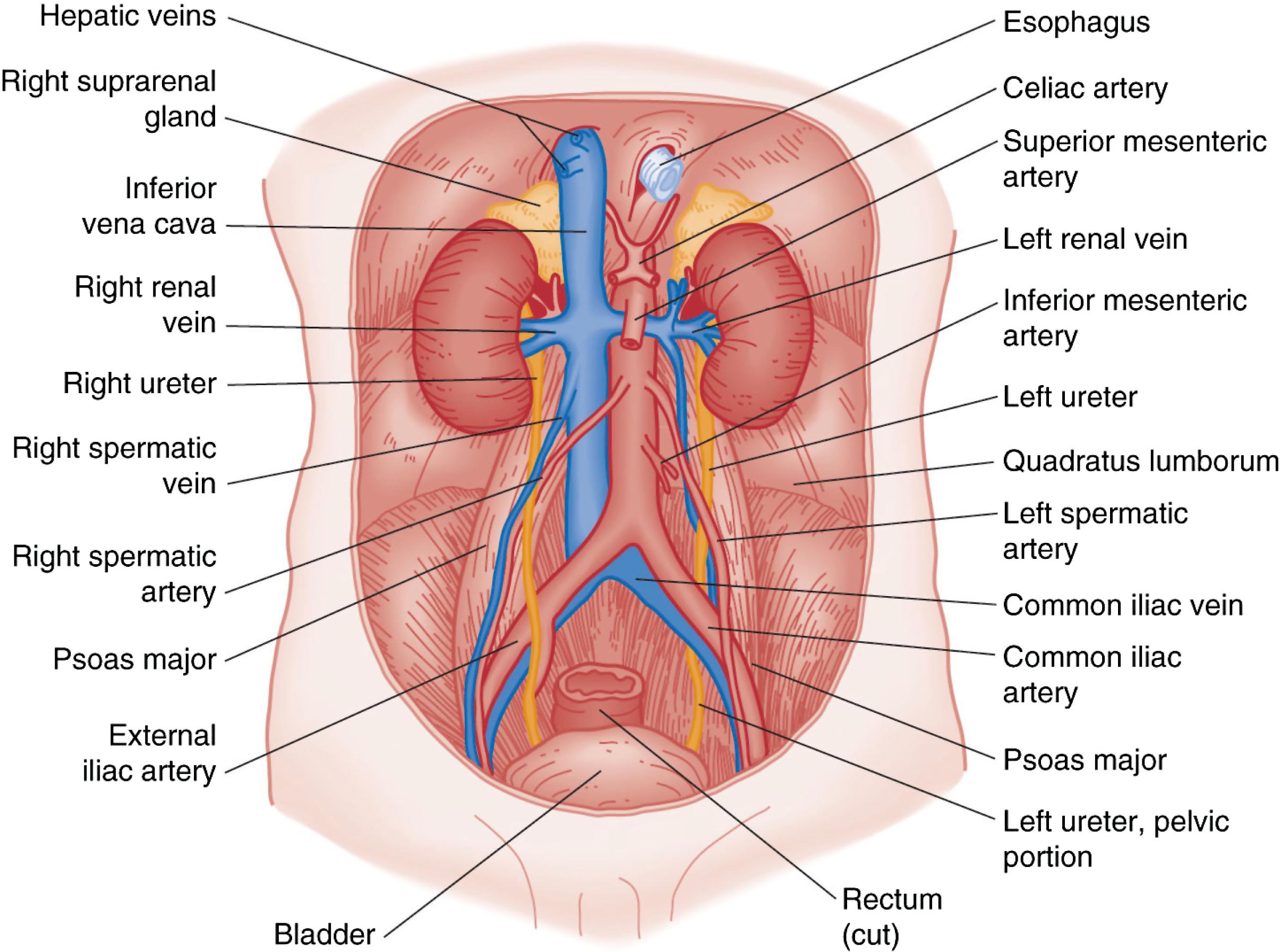
The renal pedicle—which includes the renal artery, renal vein, and the ureter—inserts into the kidney along the medial border, at the hilum. A longitudinal cross-section of the kidney reveals the outer renal cortex with inner medulla that compose the renal parenchyma ( Fig. 39.2 ). These create and drain urine into the calyces, which flow into the renal pelvis, which then drains into the ureter.
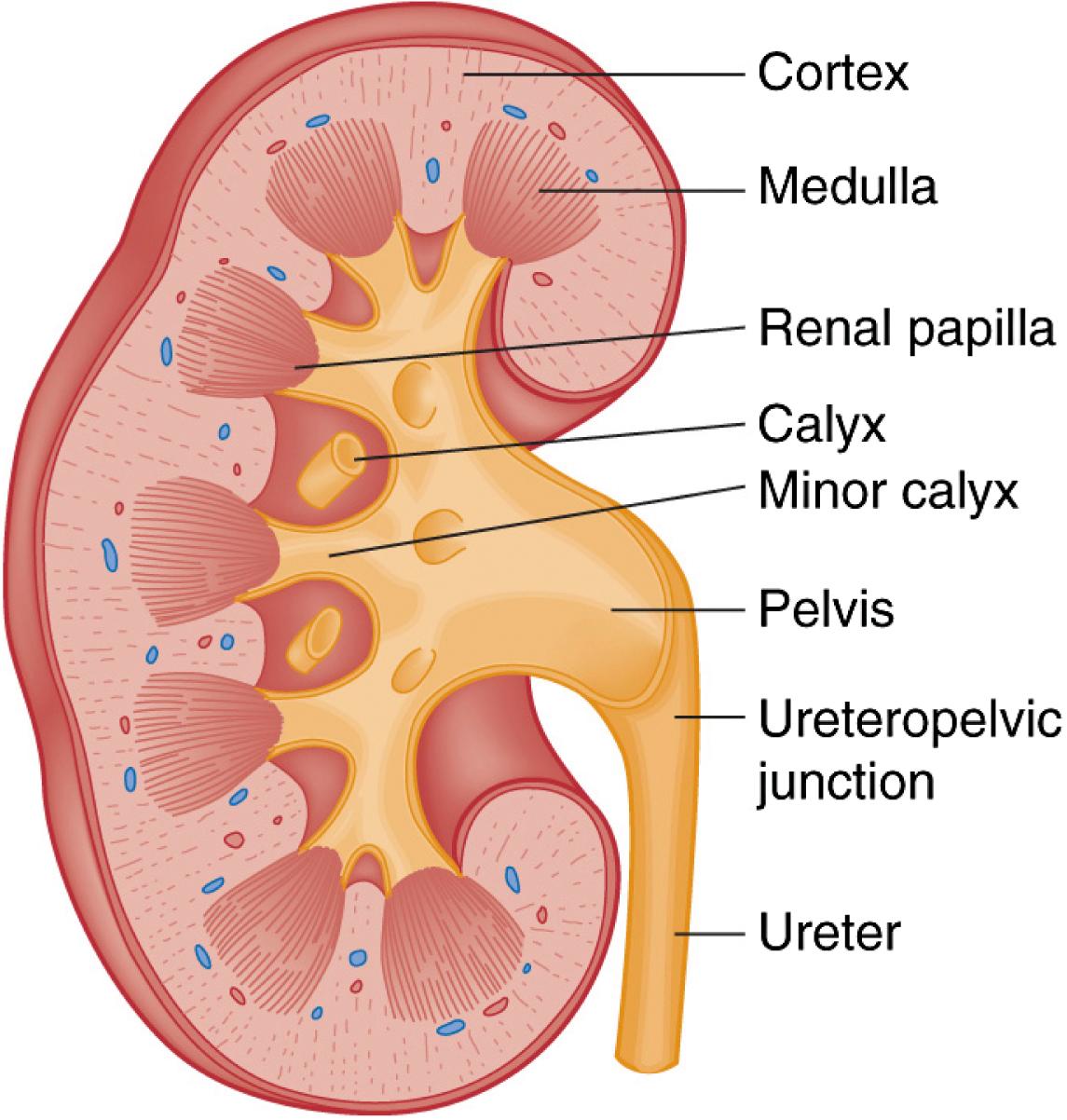
The bladder is a muscular organ that lies in the abdomen at birth but descends into the pelvis at approximately 6 years old and is thus considered extraperitoneal. It is heavily protected by the bony pelvis, especially when it is not distended. However, when distended, the dome of the bladder rises into the abdomen (as high as the umbilicus), making it more prone to both blunt and penetrating trauma. Children are more prone to bladder injuries due to their underdeveloped pelvic structures. Posteriorly, the bladder connects to the ureters on the superior aspect, and in males, it is adjacent to the seminal vesicle and vas deferens on the inferior side. Loose connective tissue surrounds the bladder laterally.
The male urethra is approximately 22 cm in length when measured from the bladder to the urethral meatus ( Fig. 39.3 ). The urogenital diaphragm divides the posterior urethra (composed of the prostatic and membranous segments) from the anterior urethra (composed of the bulbous and penile segments). The fossa navicularis is the slightly dilated segment of the penile urethra contained within the glans. Although the anterior urethra is more mobile, the posterior urethra is anchored to the anterior pubic arch by the puboprostatic ligaments. The female urethra is only approximately 5 cm long and is protected due to its close association with the vagina, which absorbs the majority of the force during trauma. In addition, the female urethra has no significant attachments, making it mobile, and reducing the likelihood of significant trauma.
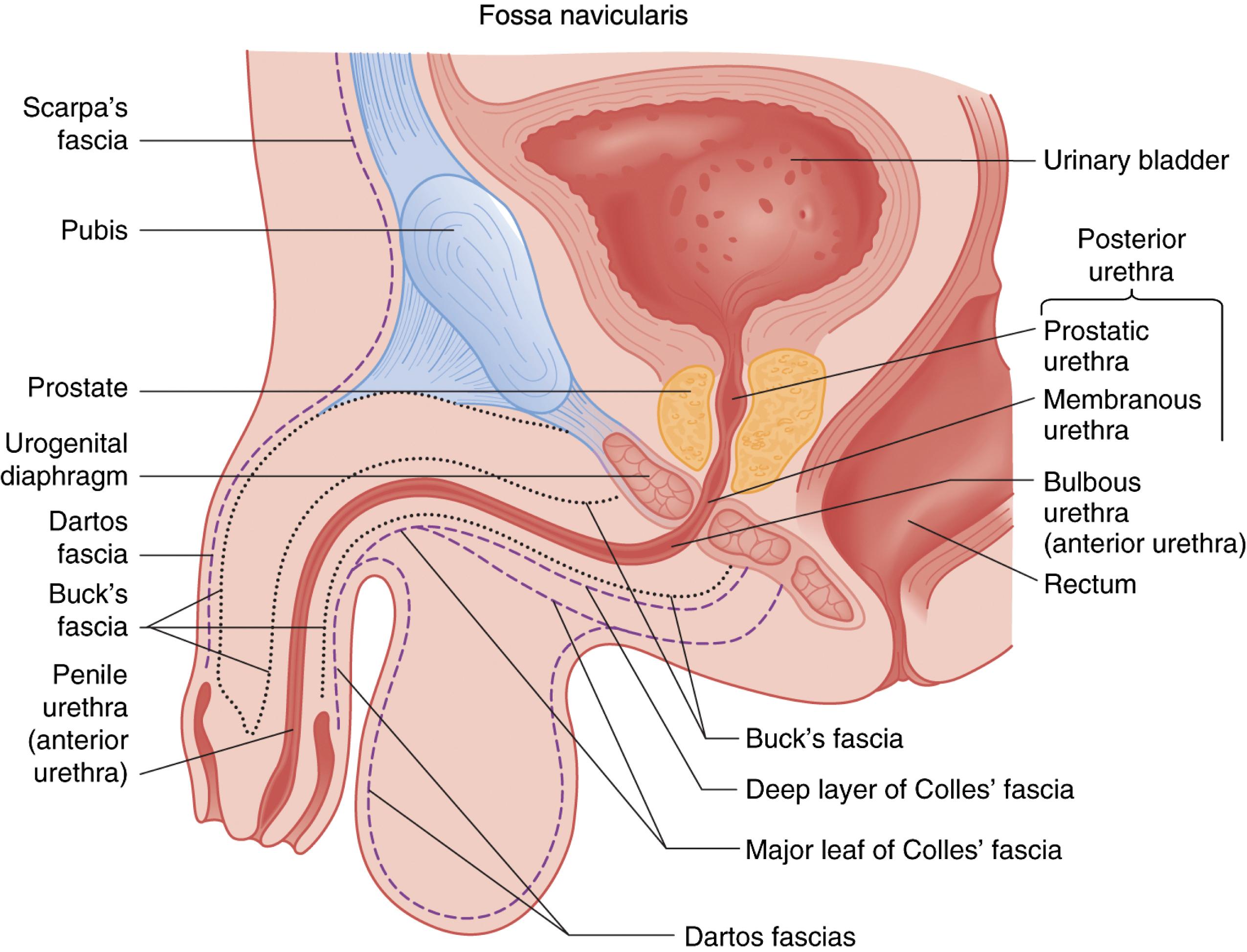
The testicles normally measure 5 × 3 × 2 cm each and are individually encapsulated by the fibrous tunica albuginea ( Fig. 39.4 ). The encapsulated testicles are then surrounded by the tunica vaginalis, which has both a visceral and parietal surface. The potential space between these surfaces allows for hydroceles or hematoceles to form. Each half of the scrotum contains a separate testicle, spermatic cord, and epididymis.
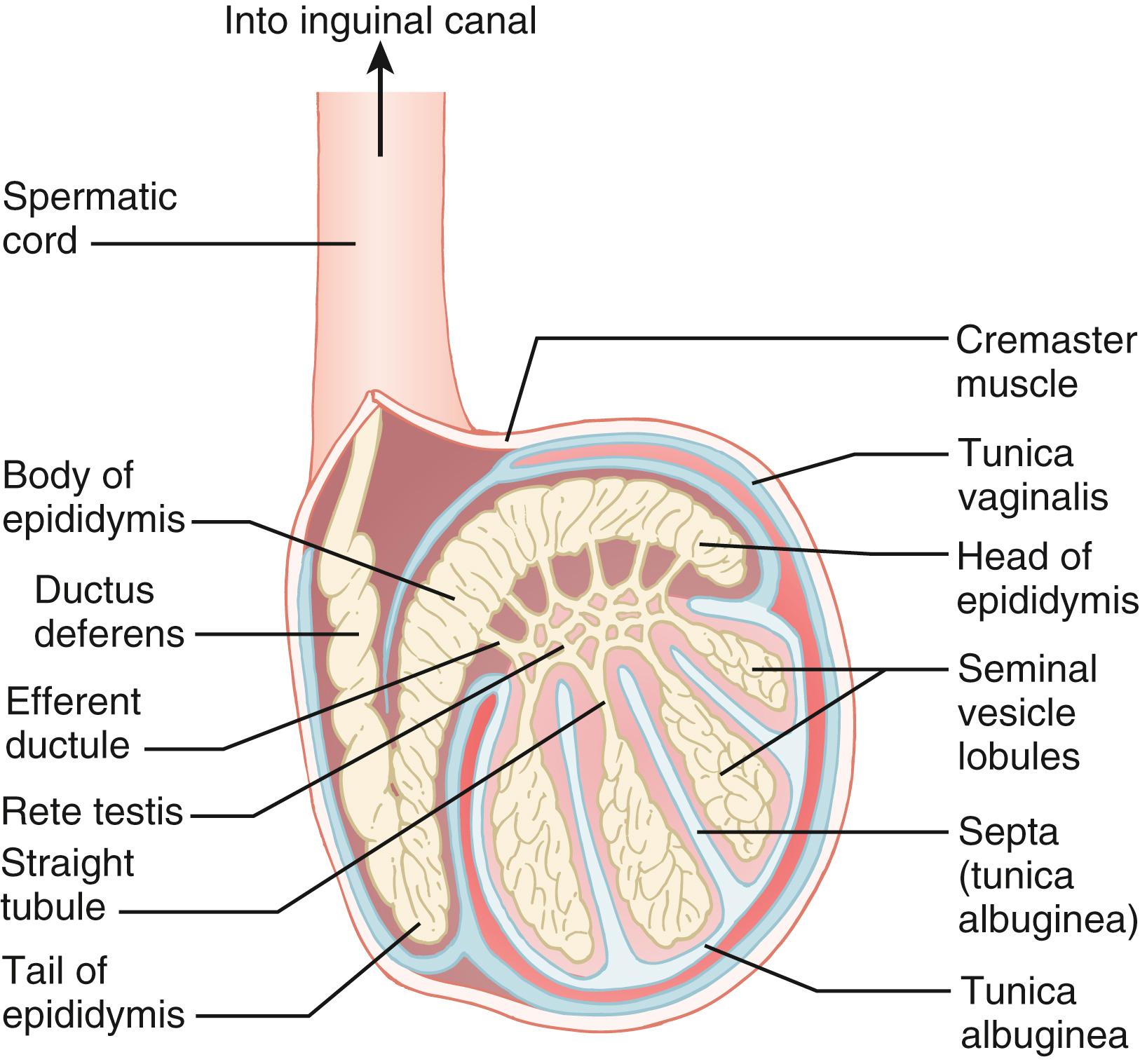
The penis is composed of two paired corpora cavernosa along the dorsal aspect and a corpus spongiosum along the ventral surface ( Fig. 39.5 ). Corpora cavernosa are filled with venous sinusoids that surround a central artery and engorge with blood during an erection, whereas the corpus spongiosum surrounds the urethra and forms the glans penis on its distal aspect. Each of the three is surrounded by a separate fascial sheath, which also is referred to as the tunica albuginea. Buck fascia, the deep fascia of the penis, immediately surrounds the three structures, and multiple other superficial fascial layers further surround Buck fascia. The superficial and deep dorsal veins provide most of the venous drainage from the penis. The female external genitalia consist of the labia, vulva, and the vagina, as well as the clitoris. The thighs and groin provide relative protection, and isolated injuries to this area should raise suspicion for physical, sexual, or otherwise intentional abuse.
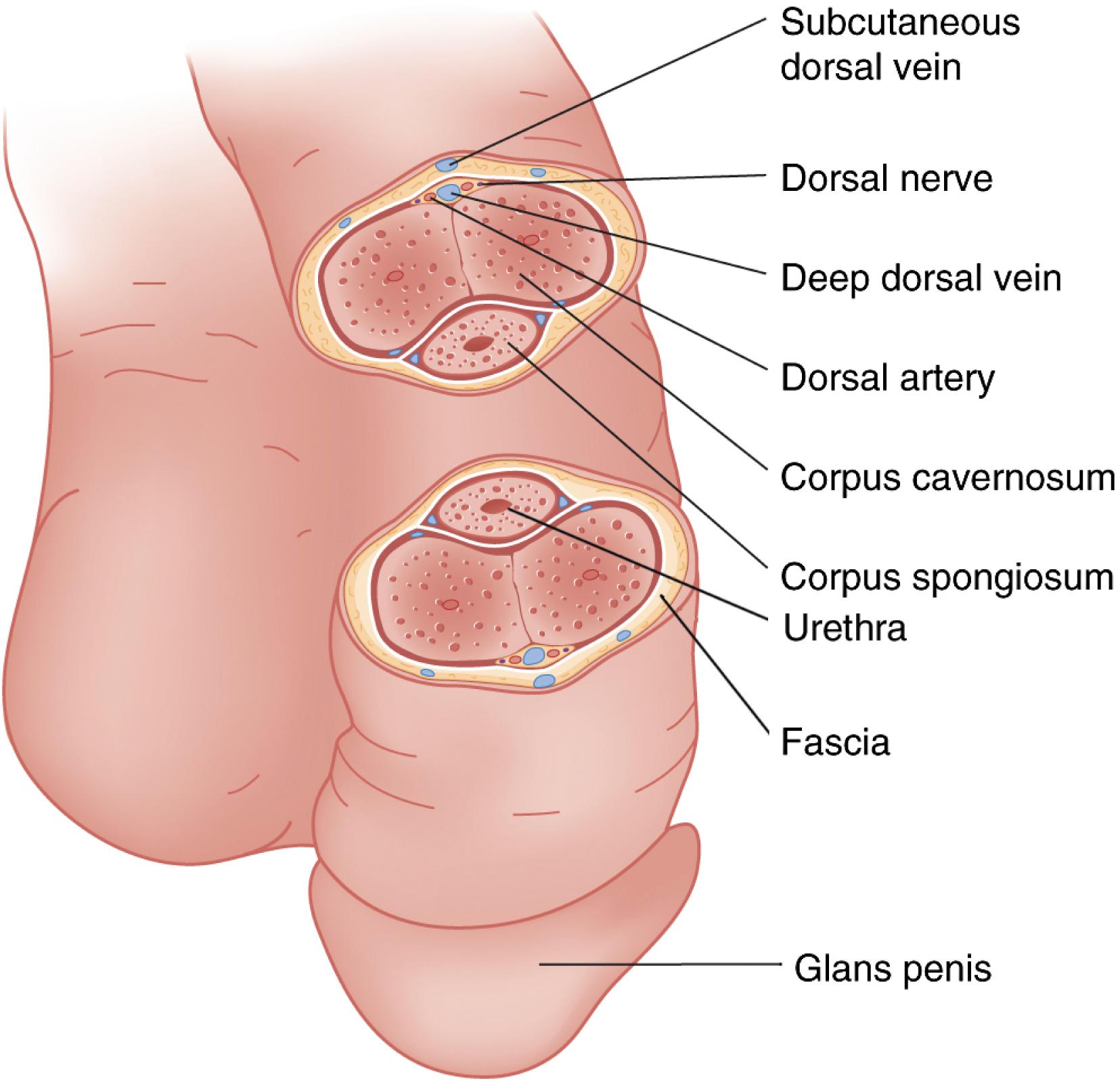
Because it is fixed in space only by the renal pelvis and pedicle, the kidney is prone to acceleration and deceleration injuries from blunt trauma. The American Association for the Surgery of Trauma (AAST) guidelines for grading blunt renal trauma are essentially unchanged since their creation, with grades III, IV, and V defined as “high-grade” renal trauma ( Table 39.1 and Fig. 39.6 ). Higher-grade injuries not only require different treatments but are predictive of future morbidity, such as risk of chronic kidney disease and hypertension. Lacerations and contusions typically occur from direct trauma, whereas renal artery avulsions can occur from deceleration mechanisms. Renal artery occlusion can occur when the renal artery is compressed between the anterior abdominal wall and vertebral bodies, or from arterial spasm due to surrounding contusions. Penetrating injuries, typically due to gunshot and stab wounds, can cause similar patterns of injury as blunt injuries but tend to be more severe.
| Grade | Type | Description |
|---|---|---|
| I | Contusion | Microscopic or gross hematuria |
| Hematoma | Subcapsular, nonexpanding without parenchymal laceration | |
| II | Hematoma | Nonexpanding perirenal hematoma confirmed to renal retroperitoneum |
| Laceration | <1 cm parenchymal depth of renal cortex without urinary extravasation | |
| III | Laceration | >1 cm parenchymal depth of renal cortex without collecting system rupture or urinary extravasation |
| IV | Laceration | Parenchymal laceration extending through the renal cortex, medulla, collecting system |
| Vascular | Main renal artery or vein injury with contained hemorrhage | |
| V | Laceration | Completely shattered kidney |
| Vascular | Avulsion of renal hilum that devascularizes kidney |
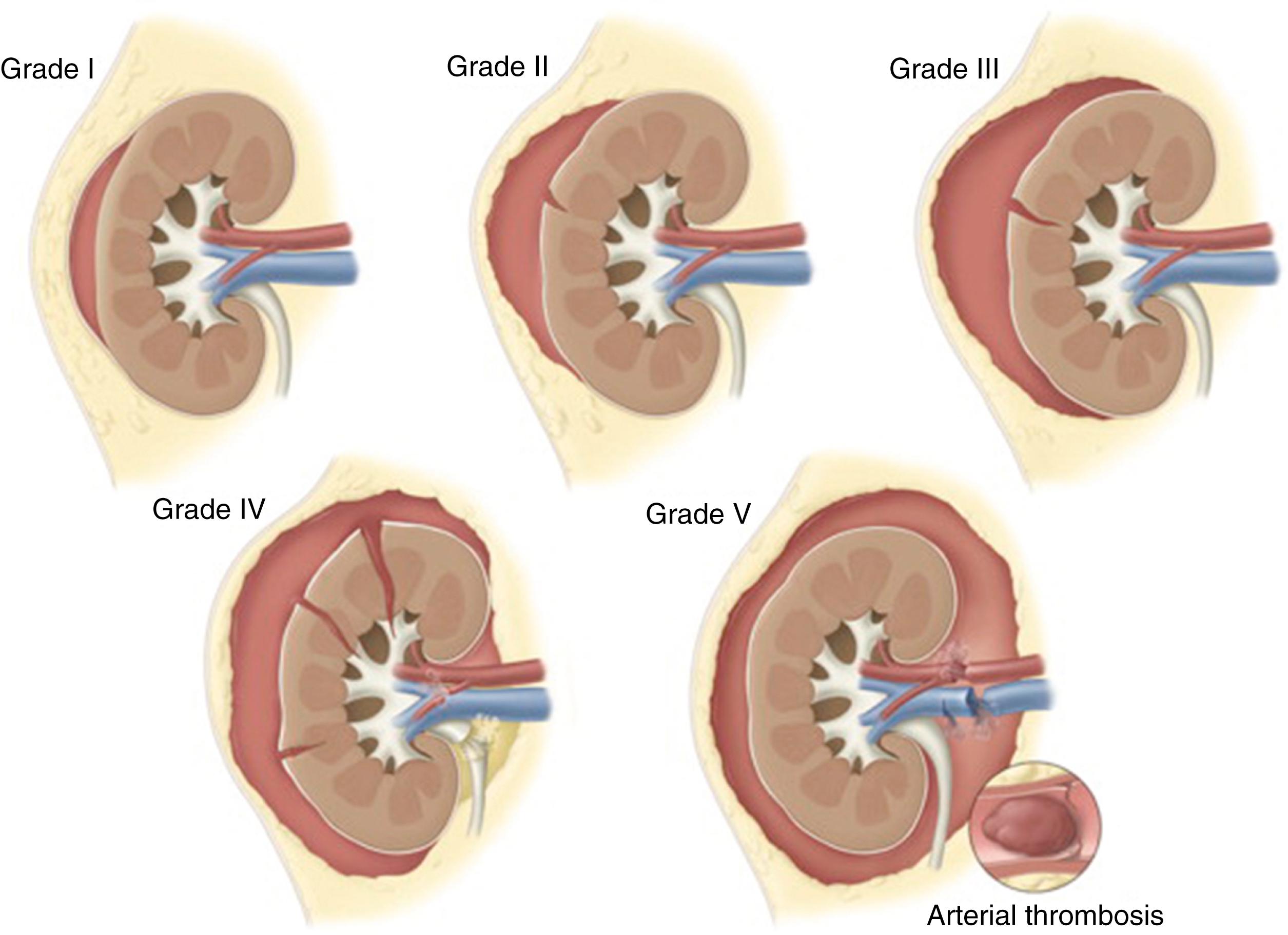
Blunt injuries can cause trauma to the ureter either directly from compression against fractured bony structures (e.g., transverse processes of lumbar vertebrae) or by deceleration mechanisms, which can cause a disruption at the ureteropelvic and the ureterovesical junctions. Due to their hyperextensible vertebral columns, children are more prone to deceleration mechanisms. Penetrating injuries are almost exclusively unilateral, tend to occur in the distal third of the ureter, and carry a mortality rate of up to 6%. They are commonly associated with bowel and vascular injuries.
Bladder injuries range from mural contusions (representing 20% of all injuries) to bladder ruptures, which are defined as lacerations through the entire wall of the bladder. Ruptures are further classified into intraperitoneal bladder ruptures (IBRs) and extraperitoneal bladder ruptures (EBRs). Intraperitoneal injuries resulting from blunt trauma are typically caused by rupture of a distended bladder at its weakest point, which is the dome where it abuts the peritoneum. As a result, urine drains into the peritoneal cavity. Intraperitoneal ruptures tend to occur in high-impact injuries, such as motor vehicle collisions, but more recently up to 10% of bladder injuries have occurred from sports-related abdominal trauma. Case reports of nontraumatic IBRs have also been reported in patients with forceful vomiting. , EBRs, which account for the majority of bladder ruptures, occur as the result of direct compression, shear forces at the bladder base, or lacerations from bony spicules from pelvic fractures. These ruptures result in urine draining into the pelvic cavity. Approximately 10% of bladder injuries are both intraperitoneal and extraperitoneal. ,
With blunt trauma to the pelvis, shearing forces transmitted through the urogenital diaphragm create tension along the male urethra, most often between the anterior and posterior segments at the bulbomembranous junction. These forces occur commonly in unstable pelvic fractures, bilateral ischiopubic rami fractures, and symphysis pubis diastasis injuries. Injuries can range from stretching, to partial lacerations, to complete disruptions of the urethra; the latter of which accounts for 50% to 65% of urethral injuries. The majority of these injuries involve the posterior urethra, and the most severe injuries are complex posterior injuries involving the bladder neck or rectum.
Blunt anterior urethral injuries, which are four times less common than posterior injuries, are often caused by straddle-type mechanisms, which result in crushing of the bulbar urethra against the inferior aspect of the pubic bone ( Fig. 39.7 ). These injuries occur more commonly in children and can be easily missed, potentially resulting in future strictures. Gunshot wounds and other penetrating injuries more commonly involve the anterior urethra than the posterior urethra. Urethral injuries in adult females are rare due to the urethra short course and relative mobility. However, female children are at higher risk, and urethral injuries in this population are associated with pelvic circle disruptions, multiple pelvic fractures, vaginal lacerations, hematomas, or sacral spine injuries.
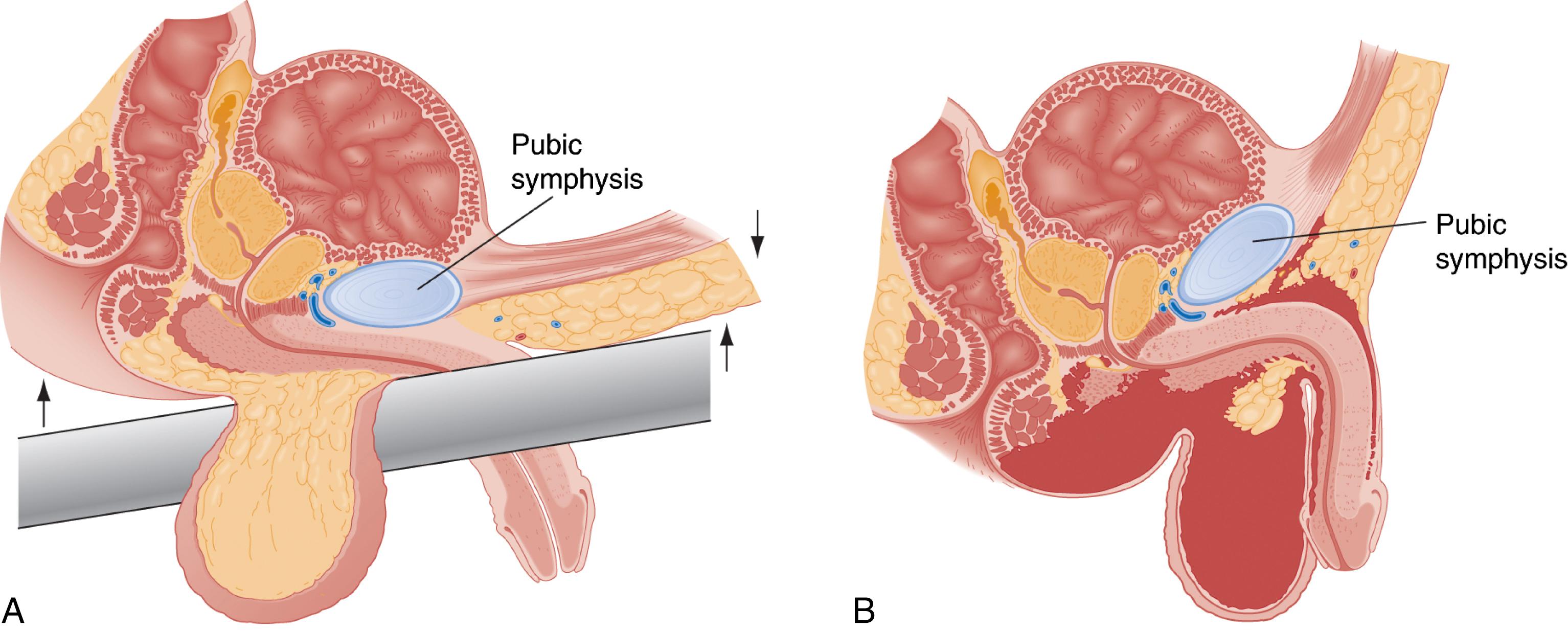
In addition to testicular rupture, which is caused by disruption of the testicular tunica albuginea, blunt trauma can also lead to scrotal hematomas, hematocele, spermatic cord injuries, testicular contusions, testicular fractures, testicular dislocation, and, rarely, traumatic testicular torsion or epidydymitis. Testicular hematomas form within the testicle and may be associated with testicular rupture, whereas testicular fractures are defined as linear avascular areas within the testicular parenchyma without rupture of the tunica albuginea. More than half of patients presenting to the emergency department (ED) with scrotal trauma may have a ruptured tunica albuginea (i.e., testicular rupture), although it is a rare injury. Testicular dislocation occurs when blunt trauma forces the extrascrotal migration of one or both testicles, although bilateral dislocations are rare. They migrate along the course of the spermatic cord and typically are found in the superficial inguinal area, but they can even be found in the suprapubic region. Penetrating injuries violate the tunica albuginea in more than half of cases.
Penile fractures, due to tears of the tunica albuginea, account for the majority of blunt penile injuries that present to the ED. Blunt trauma can also lead to rupture of the dorsal veins or artery, resulting in local ecchymosis that can be easily mistaken for a penile fracture, and is therefore termed a false penile fracture. In these cases, the tunica albuginea is typically intact, and patients do not require immediate operative exploration. Penetrating injuries to the penis involves the urethra in up to 29% of cases and can also result in penile amputation, which is more common in patients with a psychiatric history.
Nonsexual genital injuries in females are most often due to straddle injuries in young girls, but other blunt and penetrating injuries do occur and are usually more severe. The labia are most frequently involved, as well as the perineum. Penetrating injuries can involve the rectum as well as urethra, and these deeper injuries can easily be missed in young girls if a thorough examination is not performed.
The diagnostic and management approach to each organ varies, necessitating a basic understanding of the anatomy and traumatic pathophysiology of each individual organ. The majority of cases require early urologic consultation. The clinical features, diagnostic approach, and management guidelines for the specific organs are discussed in the following sections.
The history for patients with renal trauma includes the mechanism of injury for blunt trauma and the type of projectile or weapon for penetrating injury. Any high-energy impact or direct blow to the flank or abdomen can lead to renal injuries. Various other traumatic injuries tend to accompany renal injuries due to the significant anatomic protections of the kidneys. Gross or microscopic hematuria warrants careful consideration for genitourinary injury, although the degree of hematuria does not necessarily correlate with the degree or grade of injury, and significant genitourinary trauma can occur without hematuria. Importantly, hematuria can represent injury at any level of the genitourinary system and does not localize to the kidneys. Renal injury requiring intervention is rare in the absence of gross hematuria or shock. Examination of the patient with multisystem trauma may reveal shock; flank tenderness, fullness, or ecchymosis; loss of flank contour; obviously fractured ribs; abdominal tenderness or distention; or a palpable abdominal mass.
Blunt or penetrating trauma can result in a range of injuries to the kidney and the vascular supply to the kidney, as shown in Table 39.1 . Injuries to the renal parenchyma can cause contusions or lacerations within the kidney or hematomas surrounding the kidney. Vascular injuries can involve the renal artery or vein and vary in significance. Minor injuries to the vascular supply can lead to a contained hematoma, but hilar avulsion can result in complete devascularization of the kidney.
Although significant renal injury can occur without causing hematuria, 95% of all patients with renal trauma have some hematuria on urinalysis, which is defined as more than five red blood cells per high-power field, or a positive urine dipstick. Patients with multisystem trauma, especially with evidence of blood loss, require a complete blood count and type and screen. Creatinine drawn within an hour of injury reflects renal function prior to the injury and thus serves as a baseline for future testing.
Gross hematuria in a patient with a mechanism consistent with possible renal injury requires further investigation. Conversely, microscopic hematuria in a blunt trauma patient without shock is not a definite indication for renal imaging, even if there is evidence of mild local trauma, in the absence of other clinical signs. Although renal injuries may uncommonly be identified on imaging, the injuries are mild and patients typically do not require intervention. Imaging should be performed, with either gross or microscopic hematuria, in trauma patients with evidence of hemodynamic instability (systolic blood pressure less than 90 mm Hg), presence of lower rib fractures, significant flank ecchymosis, evidence of intraperitoneal injury, or specific mechanisms (e.g., rapid decelerations, significant blow to flank, or penetrating injuries). In addition, with gross hematuria, imaging should include the entire urinary tract or localized to the lower tract (bladder and urethra), depending on the mechanism and location of the injury.
Multidetector computed tomography (CT) with intravenous (IV) contrast is the gold standard to evaluate for renal injury, with nearly 100% sensitivity and specificity. CT can evaluate for renal lacerations, hematomas, extravasation of contrast, devascularized renal segments, and urinary extravasation and is used to provide a grade for the severity of renal trauma ( Fig. 39.8 ). When renal injuries are highly suspected or visualized in real time, delayed images should be performed 10 minutes after administration of IV contrast to better evaluate the extent of injury, as well as to assess for collecting system disruption, possible urinary extravasation, or accompanying ureteral damage. ( Fig. 39.9 ). In pediatrics, CT with IV contrast remains the gold standard, and obtaining initial delayed imaging can result in avoidance of repeated imaging later during the hospitalization, lowering the overall radiation to the child.
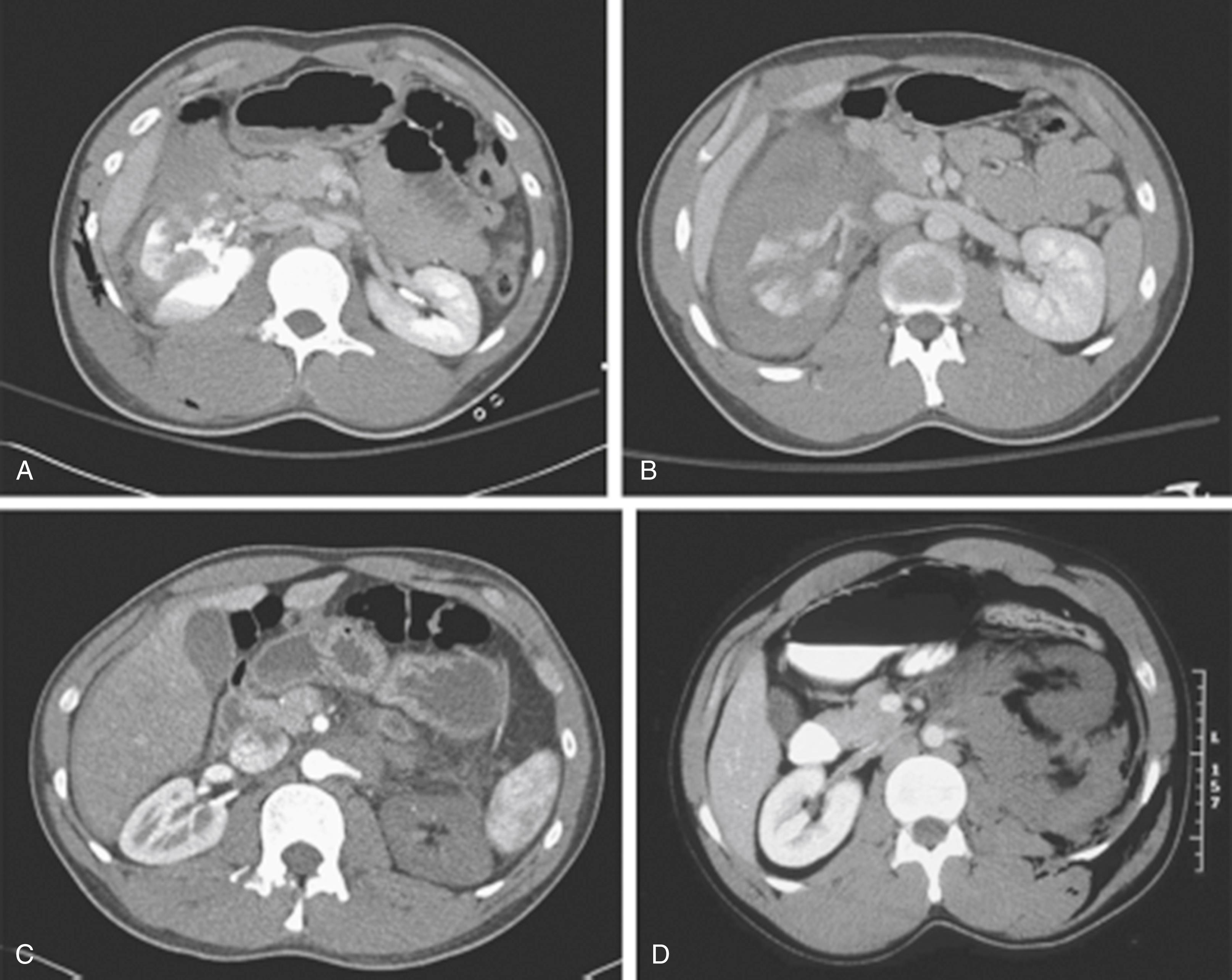
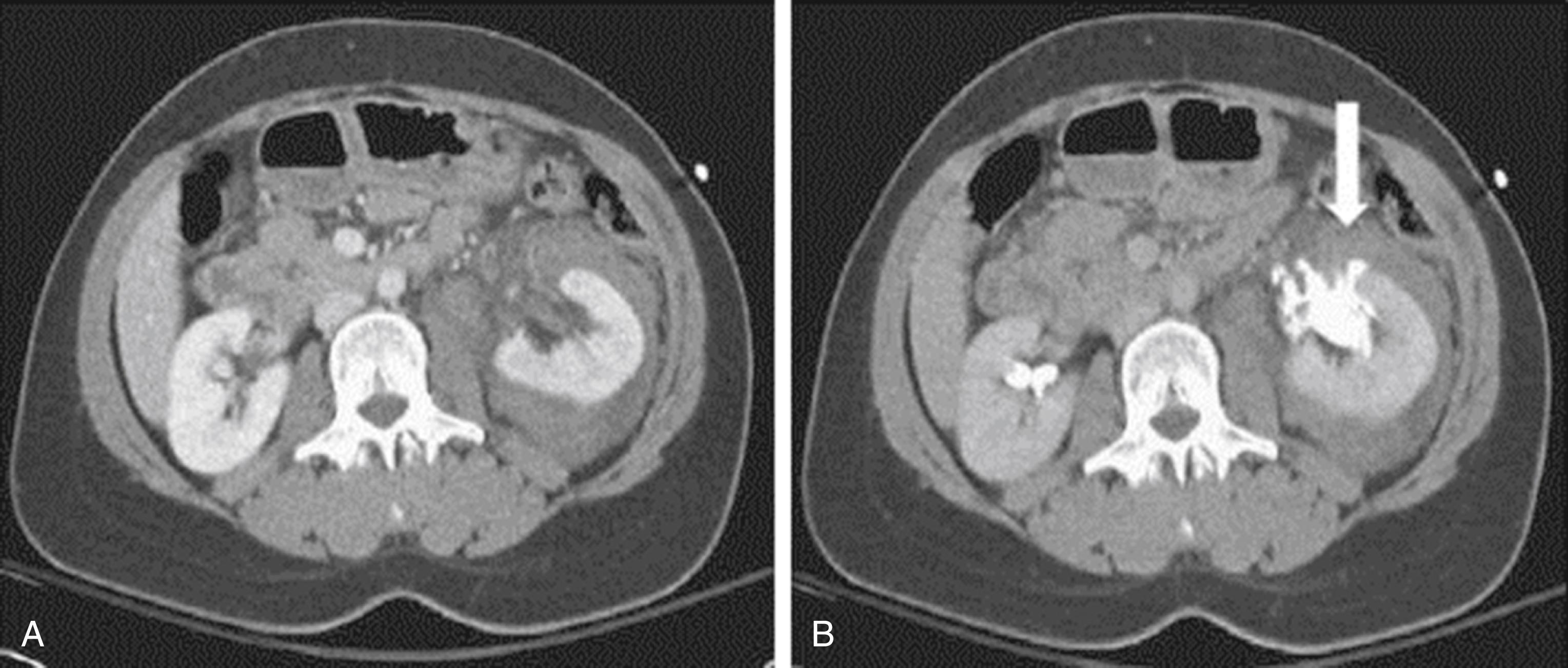
Ultrasound can demonstrate renal injuries but has historically had lower sensitivity and specificity than CT, but the quality and predictability is operator dependent. It is also difficult to determine the depth and extent of renal lacerations, and it is often unclear if fluid seen surrounding the kidney on ultrasound represents urine or blood. However, unlike CT, ultrasound can be performed at the bedside if the patient is unstable and is often used in various other ways during an initial evaluation of a multisystem trauma patient because views of both kidneys are obtained during a focused assessment with sonography in trauma (FAST) examination. Recent studies have demonstrated comparable diagnostic accuracy with renal ultrasound in pediatric patients in both isolated renal injuries and multisystem trauma patients. Importantly, either radiologists or ultrasound technicians were performing the studies, and these data might not be applicable without those specialists present.
Multisystem trauma is managed in collaboration with a general or trauma surgeon, and prompt consultation with a urologic surgeon is indicated when there is injury to the urinary tract. Fig. 39.10 represents an algorithm for the management of blunt trauma to the kidneys. After renal trauma is identified on imaging, hemodynamic instability determines the next intervention. If the patient is unstable despite fluid resuscitation, they should undergo surgical exploration, with the extent of renal trauma determined intraoperatively. Hemodynamically stable patients found to have minor renal injuries (grade I to III) typically require only conservative management (including fluid resuscitation and observation). High-grade injuries (grade IV and V) are more likely to require operative intervention; however, over the past decade, even high-grade injuries (grade IV and V) are increasingly treated nonoperatively initially, with comparable outcomes.
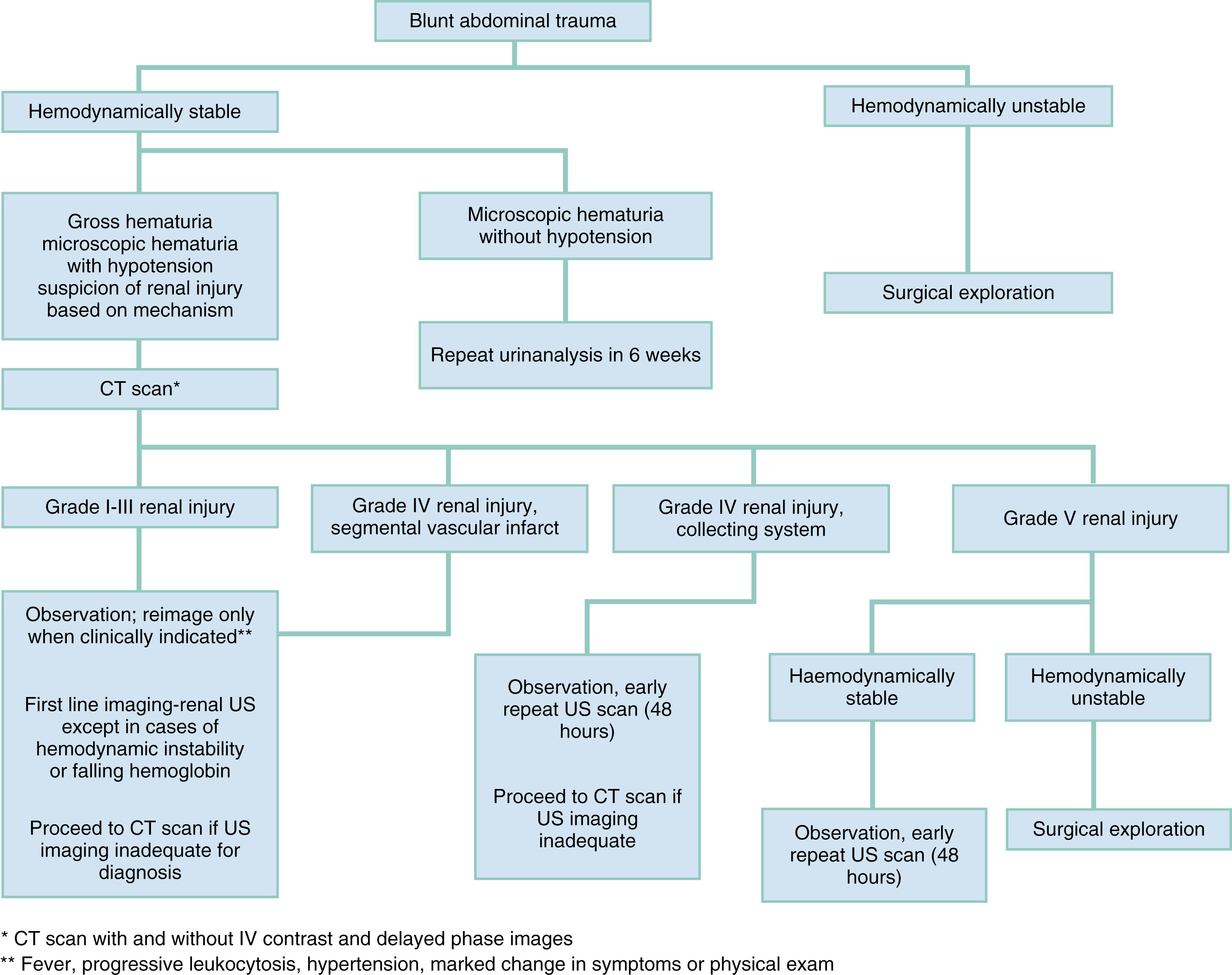
Therapeutic options for blunt renal trauma include nephrectomy, ureteric stenting, percutaneous drainage, and arterial embolization. Recent changes in management have increasingly focused on nonoperative therapy, leading to increased renal salvage in even high-grade injuries. Surgical practice has shifted away from early exploration due to the high number of nephrectomies performed with early exploration. Both European and American urotrauma guidelines advocate for nonoperative initial management for all hemodynamically stable patients. The rates of renal salvage and decreased morbidity has improved alongside more advance endoscopic and transarterial embolization techniques. This shift has been even more pronounced in the pediatric population, where the renal salvage rate now approaches 99%. In the past, penetrating renal injuries mandated urgent surgical exploration. More recently, urologists treat penetrating injuries with observation or embolization. Importantly, some injuries might require operative intervention, but morbidity and nephrectomies are decreased if operative management is performed in a delayed fashion. , ,
Although initial nonoperative management is preferred, certain factors do predict future need for operative management. Ten percent of grade IV injuries will require an open surgical procedure, and this number increases to approximately 50% for grade V injuries. In addition, deceleration mechanisms, persistent hemorrhage, fevers, multiple comorbid injuries, and initial angioembolization all predict the need for surgical intervention. The decision to obtain repeat CT imaging should be guided by individual patient characteristics and is not necessary for every patient with a renal injury. Hemodynamic instability, decreased hemoglobin, and fevers are the most common reasons for obtaining repeat CT.
Early complications of renal trauma include persistent bleeding, infection (urinary tract infections, perinephric abscesses, and sepsis), persistent urinary extravasation and urinoma, and transient hypertension. In general, early antibiotics should be considered for all patients with renal trauma to potentially avoid future urinary tract infections and perinephric abscess formation. Long term, patients most commonly suffer from chronic kidney disease and hypertension and can develop urinary fistulae and arteriovenous malformations. The risk of chronic complications increases with the grade of the injury. Grade III, IV, and V injuries are associated with a decrease in renal function of 15%, 30%, and 65%, respectively, after trauma. High-grade injuries are associated with increased rates of hypertension as well, because grades IV and V are associated with a 3.5-fold higher risk of being diagnosed with hypertension in the future.
Patients with traumatic renal injury generally require urgent evaluation by a urologist. Despite low rates of early complications, it recommended that patients with renal injuries be at least observed for repeat examinations and serial diagnostic studies. Hospital length of stays tends to be of similar with conservative or operative management. As with many traumatically injured patients, those with renal injuries tend to have better outcomes in high-volume tertiary care centers, where patients require fewer operations and have improved renal salvage rates. Because the majority of patients with renal injuries have concomitant traumatic injuries, consultation with both trauma and urologic surgery services is important in determining the appropriate disposition for these patients.
There are no pathognomonic clinical signs of ureteral injury, and suspicion must be based on mechanism and signs of other traumatic injuries on physical exam. These include signs of intra-abdominal or retroperitoneal injury, including flank ecchymosis, gross or microscopic hematuria, and abdominal distention or tenderness. However, hematuria is seen in less than half of patients and is usually microscopic. Associated injuries include fractures of the transverse process of lumbar vertebrae, pelvic fractures, bowel injuries, and vascular damage, particularly of the iliac vessels given their proximity to the ureters. Importantly, because the majority of these patients have multisystem traumatic injuries, they typically do not have complaints attributable to the ureter, despite having a significant injury. Given their subtle presentation, if not rapidly diagnosed by imaging or intraoperatively, ureteral injuries often do not declare themselves until days later when patients present with sepsis (from urinary extravasation), hydronephrosis from obstruction, or a urinary fistula.
Become a Clinical Tree membership for Full access and enjoy Unlimited articles
If you are a member. Log in here